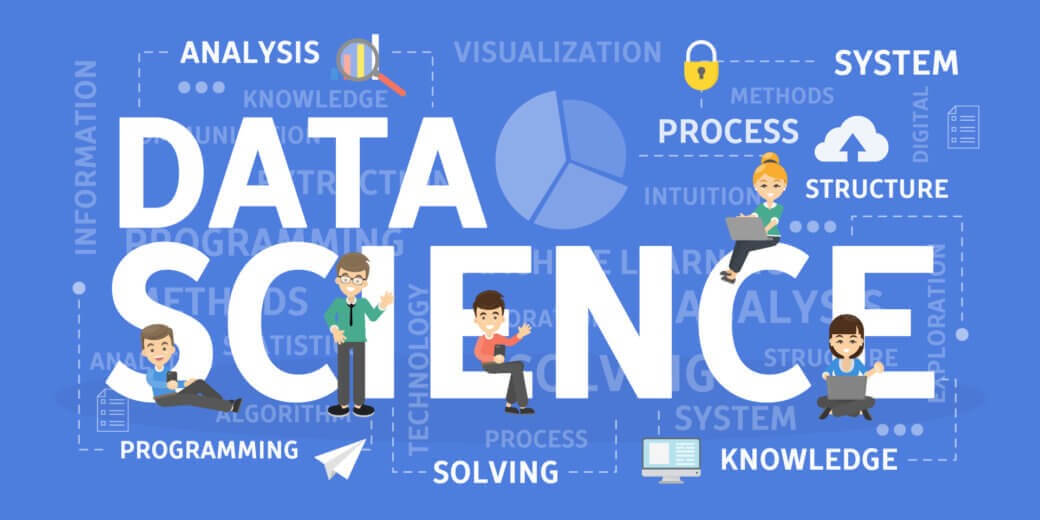Connect with our experts to learn more.

8 Essential Python Libraries for Data Scientists
Python is a general-purpose coding language that is extremely flexible. It can be used for general web development, building web-based applications, executing various scientific computing applications, and engaging in various data science fields (including machine learning). The syntax emphasizes code readability and English keywords over punctuation and shorthand, making it easy to read, maintain, and update.
For these reasons, Python is a favorite of data scientists and why it’s one of two languages you’ll learn in the QuickStart Data Science Bootcamp.
In this article, we look at why data scientists use Python libraries and the eight best ones to know if you want to get into data science.
What Are Python Libraries?
Many Python mechanisms are repeatable, and these reusable chunks of code are known as "libraries." They can be used in virtually any application where those core functions are needed. More precisely, a library is a collection of modules, and a package is a library that can be installed using a package manager.
The Python Standard Library comes bundled with all core Python distribution and comprises more than 200 core modules — the most frequently used chunks of code in the Python language. Reviewing these modules can give you tremendous insight into how Python works because they contain the exact syntax, token, and semantics of this versatile programming language.
How Do Data Scientists Use Python Libraries?
Data scientists are primarily concerned with taking substantial amounts of data and manipulating them so that unique insights can be gleaned from them. The more precise the target, the more specific the tools scientists must employ to discover them. By definition, data science is an interdisciplinary field, which means it’s more concerned with the data points and trends than the subject matter the information references.
Python holds three main appeals for data scientists: readability, robust libraries, and popularity.
Start your 30-day FREE TRIAL and begin your Python certification journey today!
Python is Easily Human Readable
Since data scientists are coming from every conceivable background, the ability to pick up a language quickly is critical. Python’s common-sense syntax lends itself to ease of use in this incredibly diverse field.
Python Has Powerful Open Source Libraries
The second reason has to do with libraries. Python has been used in data science for nearly three decades, and the number of analytical and dedicated libraries available for free download is impressive. Scientists from any field can find packages that have already been created for their applications. Often, a few modifications and combinations are all that is needed to begin generating insights.
Python is Incredibly Popular Among Data Scientists
Finally, the reason virtually all data scientists use Python is simply that nearly all data scientists use Python. Although it’s a general-purpose language, it isn’t specifically designed for statistical analysis and wasn’t even applied in this field until years after it was developed. However, scientists quickly saw the value of standardizing data analysis tools across all disciplines, permitting apples-to-apples comparisons to be completed efficiently rather than taking an extensive amount of time to rewrite analytical processes. This self-reinforcing standardization has made Python indispensable to the scientific community, and Python libraries form a core aspect of that advantage.
8 Python Libraries for Data Scientists
Although thousands of Python libraries exist, a few of them tend to be far more widely used by data scientists than others. These eight represent commonly-referenced cross-disciplinary Python libraries that every data scientist should be familiar with.
1. Pandas
The name "Pandas" comes from the term "panel data," an econometrics term that refers to multidimensional structured data sets. It's open-source and was initially established by Wes McKinney.
Pandas can take data from a CSV/TSV file or SQL database and create a “data frame” with columns and rows similar to Excel. Because a data frame closely resembles a table in statistical software, it’s easier to work with than dealing with long lists.
2. NumPy
This library is a direct descendant of Numeric, an application of a matrix package, and was combined with multiple features of Numarray to create NumPy. It supports massive, multidimensional arrays and matrices. It is programmed to work well with various high-level mathematical functions (such as linear algebra, matrices, and Fourier transform) necessary to parse through large datasets effectively.
One of the advantages of NumPy is its speed. Because it works off of array objects, it can process arrays up to 50 times faster than traditional Python lists can.
3. Matplotlib
If you're going to be using visual plots, Matplotlib will be your best friend. Providing an object-oriented API used to embed plots into applications, it operates off of a general-purpose graphical user interface (GUI). Some of the most commonly used plots in this library include bar charts, error charts, histograms, plots, power spectra, and scatter plots. Because plotting with large data sets can quickly become complicated and confusing, Matplotlib also includes features to manipulate visual elements, including font properties, line styles, and axes properties.
4. PyTorch
Primarily used for applications like natural language processing (NLP) and computer vision, PyTorch was mainly developed by Facebook's Artificial Intelligence Research (FAIR) lab. It's seen in numerous high-profile applications, including Tesla Autopilot and Uber's Pyro.
The method PyTorch uses is called "automatic differentiation," which essentially works backward to build deep neural networks. Operations are recorded, then replayed in reverse to compute the gradients that drove the process.
5. Scikit-Learn
This software machine learning library integrates closely with other libraries, such as NumPy, Matplotlib, Pandas, and SciPy. It has numerous tools for classification, clustering, and regression algorithms. Some of the most common processes include gradient boosting, k-means, random forests, and support vector machines. It also supports density-based spatial clustering of applications with noise (DBSCAN), one of the most common data clustering algorithms and most frequently cited in scientific literature.
6. TensorFlow
The TensorFlow library is also used for neural networks and other machine learning applications. It heavily relies on symbolic math, making it ideal for dataflow and differential programming in numerous applications. It was initially created for internal use by Google and released for public access in late 2015. It has a flexible architecture that can run on multiple resource levels, from a network of CPUs to an individual Android or iOS mobile device. The computations TensorFlow produces are expressed in stateful dataflow graphs.
7. Keras
Closely related to TensorFlow is Keras, which is a Python interface for the TensorFlow library. Its primary application is rapid experimentation with deep neural networks and is also used for standard, convolutional, and recurrent neural networks. To do this, Keras relies on commonly used building blocks like activation functions, layers, objectives, and optimizers. It’s designed to be user-friendly, extensible, and modular so that working with both images and text data is drastically simplified.
8. SciPy
SciPy is a popular Python library that’s primarily applied in both technical and scientific computing. Because its base is so broad, you'll find modules for numerous everyday tasks in engineering and other scientific disciplines. These include image and signal processing, integration, interpolation, linear algebra, and optimization.
The library boasts nearly a score of cornerstone functions and algorithms central to Python's scientific computing applications. It commonly integrates with Pandas, Matplotlib, and SymPy.
The Numerous Benefits of Python Libraries
Python is a widely-used programming language within the scientific community, making it the perfect solution for a cross-disciplinary arena like data science. Python’s easily-readable syntax permits virtually any scientist to pick up the core elements of the language easily.
These Python libraries make data analysis and machine learning relatively easy. It’s just a matter of learning how to use them. The QuickStart Data Science Bootcamp prepares future data scientists to not learn Python, but also these important data science libraries.
A quarter-century of use has culminated in numerous predeveloped libraries with repeatable modules. A data scientist from any discipline can find a library suited to their specific needs and rapidly combine multiple functions to manipulate massive data sets and generate otherwise unobtainable insights. Python’s flexibility and ease of use have cemented its role as a central element in both established and developing scientific disciplines, and libraries are a pivotal aspect.
